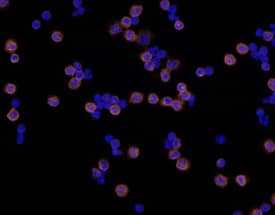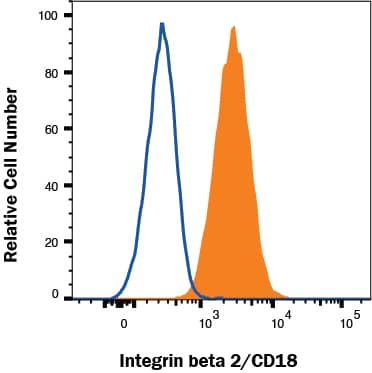Human Integrin beta2/CD18 Antibody
R&D Systems, part of Bio-Techne | Catalog # MAB1730


Key Product Details
Species Reactivity
Validated:
Cited:
Applications
Validated:
Cited:
Label
Antibody Source
Product Specifications
Immunogen
Gln23-Asn700
Accession # AAA59490
Specificity
Clonality
Host
Isotype
Scientific Data Images for Human Integrin beta2/CD18 Antibody
Integrin beta2/CD18 in Human PBMCs.
Integrin beta2/CD18 was detected in immersion fixed human peripheral blood mononuclear cells (PBMCs) using Mouse Anti-Human Integrin beta2/CD18 Monoclonal Antibody (Catalog # MAB1730) at 10 µg/mL for 3 hours at room temperature. Cells were stained using the NorthernLights™ 557-conjugated Anti-Mouse IgG Secondary Antibody (red; Catalog # NL007) and counter-stained with DAPI (blue). Specific staining was localized to cell surfaces and cytoplasm. View our protocol for Fluorescent ICC Staining of Non-adherent Cells.Detection of Integrin beta2/CD18 in THP-1 cells by Flow Cytometry
THP-1 cells were stained with Mouse Anti-Human Integrin beta2/CD18 Monoclonal Antibody (Catalog # MAB1730, filled histogram) or isotype control antibody (Catalog # MAB002, open histogram) followed by Allophycocyanin-conjugated Anti-Mouse IgG Secondary Antibody (Catalog # F0101B). View our protocol for Staining Membrane-associated Proteins.Applications for Human Integrin beta2/CD18 Antibody
CyTOF-ready
Flow Cytometry
Sample: THP-1 human acute monocytic leukemia cell line
Immunocytochemistry
Sample: Immersion fixed human peripheral blood mononuclear cells (PBMCs)
Western Blot
Sample: Recombinant Human Integrin alphaX beta2 under non-reducing conditions only
Formulation, Preparation, and Storage
Purification
Reconstitution
Formulation
*Small pack size (-SP) is supplied either lyophilized or as a 0.2 µm filtered solution in PBS.
Shipping
Stability & Storage
- 12 months from date of receipt, -20 to -70 °C as supplied.
- 1 month, 2 to 8 °C under sterile conditions after reconstitution.
- 6 months, -20 to -70 °C under sterile conditions after reconstitution.
Background: Integrin beta 2/CD18
Integrin alphaX beta2, also called CD11c/CD18, p150/95 or complement receptor type 4 (CR4), is one of four beta2 integrins. The non-covalent heterodimer of 150 kDa alphaX/CD11c and 95 kDa beta2/CD18 integrin subunits is expressed on macrophages, dendritic cells and hairy cell leukemias, with lower amounts on other myeloid cells and activated B, NK and some cytotoxic T cells (1‑7). Like other integrins, alphaX beta2 has multiple activation states (3). In the presence of divalent cations and "inside-out" signaling, alphaX beta2 is fully active and extended. The alphaX vWFA or I-domain, which contains the adhesion sites, forms the N-terminal head region with the alphaX beta-propeller and the beta2 vWFA domain (1, 8). In the inactive state, the heterodimer flexes in the center at the alphaX thigh and calf domains and beta2 I-EGF domains, impeding access to adhesion sites (1). The 1088 aa human alphaX/CD11c ECD shares 70‑76% aa sequence identity with mouse, rat and canine alphaX while the 678 aa human beta2/CD18 ECD shares 81‑83% aa sequence identity with mouse, rat, cow, dog, goat, sheep, and pig beta2. Potential alphaX isoforms containing 719 and 725 aa (as compared to full-length 1163 aa alphaX) lack the vWFA domain and the N-terminus. Active alphaX beta2 shares some adhesion partners with alphaM beta2/CD11b/CD18, including complement opsonin fragment iC3b, ICAMs, vWF and fibrinogen, and is expressed on many of the same cells (4‑11). However, alphaM beta2 activity is often constitutive, while alphaX beta2 activity requires cell activation (4‑7). alphaX beta2 also binds osteopontin, Thy-1, plasminogen, heparin, and proteins with abnormally exposed acidic residues (11‑16). The adhesion events are important for proliferation, degranulation, chemotactic migration, and phagocytosis of complement-opsonized particles (5, 6, 9, 11, 12, 16). Mutations of beta2, especially in the vWFA domain, cause leukocyte adhesion deficiency (LAD-1) and susceptibility to bacterial infections (17).
References
- Corbi, A.L. et al. (1987) EMBO J. 6:4023.
- Kishimoto, T.K. et al. (1987) Cell 48:681.
- Hynes, R.O. (2002) Cell 110:673.
- Arnaout, M.A. (1990) Blood 75:1037.
- Postigo, A.A. et al. (1991) J. Exp. Med. 174:1313.
- Beyer, M. et al. (2005) Respir. Res. 6:70.
- Nicolaou, F. et al. (2003) Blood 101:4033.
- Vorup-Jensen, T. et al. (2003) Proc. Natl. Acad. Sci. USA 100:1873.
- Bilsland, C.A.G. et al. (1994) J. Immunol. 152:4582.
- Pendu, R. et al. (2006) Blood 108:3746.
- Sadhu, C. et al. (2007) J. Leukoc. Biol. 81:1395.
- Schack, L. et al. (2009) J. Immunol. 182:6943.
- Choi, J. et al. (2005) Biochem. Biophys. Res. Commun. 331:557.
- Gang, J. et al. (2007) Mol. Cells 24:240.
- Vorup-Jensen, T. et al. (2007) J. Biol. Chem. 282:30869.
- Vorup-Jensen, T. et al. (2004) Proc. Natl. Acad. Sci. USA 102:1614.
- Kishimoto, T.K. et al. (1987) Cell 50:193.
Alternate Names
Gene Symbol
UniProt
Additional Integrin beta 2/CD18 Products
Product Documents for Human Integrin beta2/CD18 Antibody
Product Specific Notices for Human Integrin beta2/CD18 Antibody
For research use only
